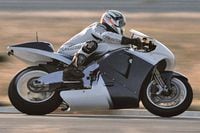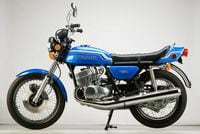While it may be easy for some to jump to the conclusion that the final timesheet order seen at the first Sepang test will be how the 2015 season will play out, the truth is that the jury is still out because the technical aspect—a very important factor in a category such as MotoGP—is still undecided. Apart from Honda, no other manufacturer arrived in Malaysia last week with their new bikes. In the case of Yamaha, for example, riders and technicians are waiting for the arrival of the “real” 2015 M1; the one used in these first tests can be called a preview of what’s to come. At Ducati, it was not even that. The bikes the two Andreas—Dovizioso and Ianonne—rode in Malaysia were yet another version of the GP14, in this case designated the GP14.3.
Meanwhile, Repsol Honda riders Marc Marquez and Dani Pedrosa did have their 2015 machines. A situation that allowed both to do the important selection work that defines the direction to follow until the start of the season. From now on, Marquez and Pedrosa are supposed to focus in fine-tuning their chosen bikes. Honda seemingly has started with an advantage, but to better understand where everyone is in the grand scheme of the MotoGP grid, let’s analyze the situation of the five brands officially represented in MotoGP: Honda, Yamaha, Ducati, Suzuki and Aprilia.
Honda: An exhibition of power
HRC's deployment in Sepang was fairly spectacular in comparison to the other teams. While the other manufacturers showed up with their homework still to be finished, Honda's effort resembled something akin to the D-Day invasion. A total of ten riders were astride RC213Vs at Sepang, spread over the factory team, the official costumer bikes, the Open class bikes and the two test riders, All-Japan superbike rider Takumi Takahashi and former 250 world champion (and former MotoGP rider) Hiroshi Aoyama. And nearly all the bikes were the 2015 versions.
We say "nearly," because within this exhibition of resource dominance was an even more graphic display in the Repsol Honda garage. Marquez´s and Pedrosa's pitbox contained seven different RC213Vs at any time throughout the test—yes, seven. Marquez had four different RCVs, while Pedrosa had "only" three. Marquez had the following at his disposal: his 2014 RC213V, the 2015 RC213V tested in Valencia last November, and two different versions of the 2015 model designed and assembled by the HRC engineers this winter. In Pedrosa's garage, the only version missing was the latest evolution of the original 2015 prototype.
The reason for the multiple-bike test was the negative feedback from both Marquez and Pedrosa on the 2015 prototype after the post-race Valencia test in November. Both riders voiced some concerns after riding the prototype, saying that the throttle response was too aggressive and grip at the rear was an issue. After completing very intense test schedule at Sepang, the Repsol Honda team left the first preseason test at the Malaysian circuit having a clear direction to follow. Both riders chose the modified 2015 version; the original 2015 prototype was completely discarded.
Why were so many different versions of the RC213V tested at Sepang? “Honda is Honda,” said Pedrosa with a smile in his face. “A Honda has to be, by the company´s philosophy, the fastest bike on the straight. After that, they start to figure out how to make it turn…” In fact, it was on corner entry where Marquez and Pedrosa focused their testing efforts at Sepang. Both ended the test satisfied with the results and each agreed that for the next test, the focus will be on the rear of “latest” RC213V.
Yamaha: waiting for the new seamless transmission
Yamaha manages their rivalry with Honda in a very clever fashion. This may be due to experience; the company knows it cannot engage in a toe-to-toe battle with Honda's massive resources. In fact, Yamaha's approach resembles more of a guerrilla war. "I know Yamaha already for a long time", Valentino Rossi explained at Sepang. "The Yamaha philosophy is doing small steps on what they already have. They improve little by little in all areas. It is a system that also allows them to step back, so they avoid great traumas if the try is mistaken. It is Yamaha's way and it is OK for me."
The 2015 M1 at Sepang didn’t show big changes. It could be easily described as an evolution of the very competitive 2014 bike of the second half of the season. Of course, there was an update of the electronic management at the Sepang test, and Rossi and Lorenzo tested different swingarms and numerous other components we surely don’t know about. For the most part, the bike’s performance was competitive, with no surprises. But this known quantity meant that Lorenzo and Rossi kept facing the Hondas with a few-tenths of a second deficit that was difficult to overcome no matter how hard they tried.
This gap is well known by the Yamaha engineers, and it's one they have been working on the whole winter. As Kouichi Tsuji—chief engineer of Yamaha's MotoGP project—explained, this difference will get neutralized with the arrival of the new seamless gearbox for the second Sepang test. Reports from the factory say that in the bench tests, the new system cut an average of 2.2 seconds off last year's overall race time. If the track reality matches with the indoor tests, Yamaha will give Rossi and Lorenzo the tools they asked for at the second Sepang test scheduled for February 23-25.
Ducati: Waiting for the GP15
On paper, Ducati arrived at Sepang with their thinking more focused on the future GP15 than on the tests. But at the end of the three days, the atmosphere in the Borgo Panigale squad was full of optimism. And it made sense, because Ducati was probably the one team that got the most out of the test.
With last year’s bike that included some components and electronics that will soon be on the GP15, they played their cards very smartly. As happened in the second half of last season, Iannone and Dovizioso—especially Iannone—managed to take full advantage of their potential on one single lap. With a tire the Hondas and the Yamahas were not allowed to use, both were able to get into the battle for the test’s best lap time. It’s true that in the real world (read: race pace) the important thing is the rhythm, and in this area the Ducati didn’t improve compared with last year. But being up there at the end of the day gave them the right to appear in the media headlines…something that is also important.
Regarding the upcoming GP15, Gigi Dall’Igna said. “As you can imagine I can’t tell you how the new bike will look like, but let’s say that the engine will be more compact, that the electronics will be evolutioned…it will be a complete new bike compared with the actual one.”
The GP15 is probably one of the most highly anticipated MotoGP machines to debut in some time. Not only for the journalists and the fans, but also even for Dovizioso and Iannone. Knowing this expectation, Ducati will do a special online streaming press launch in Borgo Panigale before the bike even gets on the track.
Suzuki: looking for reliability
It could be said that at Sepang, Aleix Espargaró and Maverick Viñales were above the performance of the GSX-RR. Seeing Espargaró's name tenth on the final timesheets after riding a bike no less than 12 mph slower than his rivals says how much effort he put into the Sepang test. Yes, this also means that Suzuki's new MotoGP bike has virtues in other areas that compensate the lack of outright horsepower. Also very significant was Viñales' 12th place, immediately behind Cal Crutchlow on a satellite-spec RC213V. Without a doubt, Suzuki has two very talented and committed young riders on its team.
Suzuki arrived with a clear motto in Sepang: avoiding the torture of seeing their engines explode as happened in Valencia and Jerez in the November tests. Reliability is thus their number one priority, and the engineers have been working intensively during the winter in this area. But inside information admitted that the issue hasn’t been fixed so far, so there was no other solution than to cut engine performance. No engine broke in Sepang.
Suzuki’s commitment in its new MotoGP project is total, as was evident in Malaysia. Espargaró had up to three bikes in his garage, and after the test he flew directly to Japan to undergo wind tunnel test in order to get a more aerodynamic fairing for him for the next test.
So far both riders are positive towards the actual situation. They understand the development phase the project is in, and they realize that Suzuki is intensely focused on making the bikes fully competitive. The key to keep this harmony will be the rhythm of progress the engineers will be able to fulfill.
Aprilia: Hard work ahead
Aprilia's box in Sepang was at the very far end of the long pit lane, and from my point of view it was the best place to be. This allowed them to avoid being distracted by all the other teams and work on their task lists calmly. With Romano Albesiano now in charge of racing, Aprilia sent to a full crew to Sepang, showing that the company's comeback into MotoGP is serious.
In their garage, they had two different bikes: the one seen in the November test, now with an engine utilizing pneumatic valves, and a completely new bike with new chassis, new swingarm, new airbox, new fuel tank, etc. Unfortunately the new bike was a complete fiasco. When asked about what exactly didn’t work on that bike, Alvaro Bautista replied, “Nothing works, nothing…it doesn’t turn, it doesn’t stop when you brake…It simply doesn’t work. Somebody must have designed this bike in a theoretical way, how it should be in the rules, but in the real world it is unusable.”
From this standpoint, it appears that Aprilia will be racing themselves in 2015.
















/cloudfront-us-east-1.images.arcpublishing.com/octane/CG4JZR66CJBERHQUO2A5B57QOQ.jpg)
/cloudfront-us-east-1.images.arcpublishing.com/octane/3BZ5OO6MGFAP3I3MMXANK2E2UQ.jpg)
/cloudfront-us-east-1.images.arcpublishing.com/octane/EJ43BWDGNJHI3IBR7XZRUJZQ4A.jpg)


/cloudfront-us-east-1.images.arcpublishing.com/octane/OQVCJOABCFC5NBEF2KIGRCV3XA.jpg)


/cloudfront-us-east-1.images.arcpublishing.com/octane/IGNARDBROZAHXJOWS3HJX5RFLI.jpg)

/cloudfront-us-east-1.images.arcpublishing.com/octane/TS322GBUYND4DN6IB2ZU3XKUTU.jpg)


/cloudfront-us-east-1.images.arcpublishing.com/octane/7CVBAWYS7VCGNCKAMRYCVTQB4A.jpg)
/cloudfront-us-east-1.images.arcpublishing.com/octane/WFVHEBMODRB3NIBVEJVJBOYIBM.jpg)

/cloudfront-us-east-1.images.arcpublishing.com/octane/EQHT5CG5BFCVRKWUZNIIFDXGTM.jpg)
/cloudfront-us-east-1.images.arcpublishing.com/octane/FTTUUNSO5NGMDLTTE37YP7BHXI.jpg)
/cloudfront-us-east-1.images.arcpublishing.com/octane/K4JQOL7O6NEBPI2JQSXNHF5INA.jpg)
/cloudfront-us-east-1.images.arcpublishing.com/octane/ZIKOMFDEHFHOXA3Q7TBDV3ZFUM.jpg)
/cloudfront-us-east-1.images.arcpublishing.com/octane/RQO7PTDM3BEMZHUDA6ANJLXVM4.jpg)

/cloudfront-us-east-1.images.arcpublishing.com/octane/XYOOBZOUDVHSFCOBAHNWGZWP24.jpg)
/cloudfront-us-east-1.images.arcpublishing.com/octane/WX5JTLXS2VBGXHHID3GNCWCTD4.jpg)